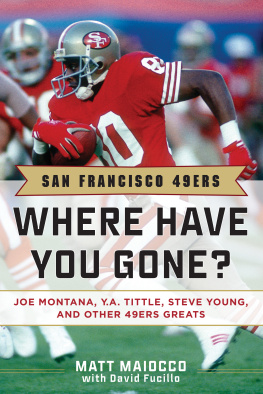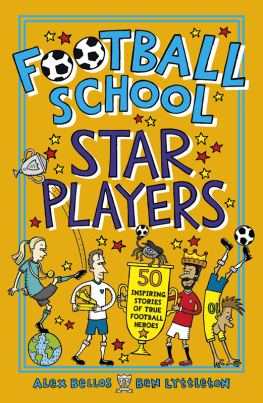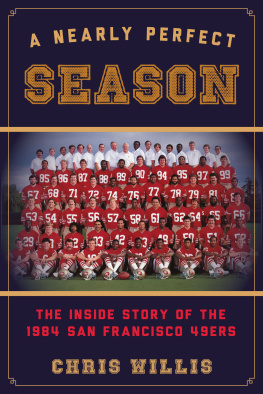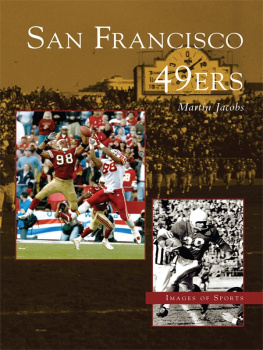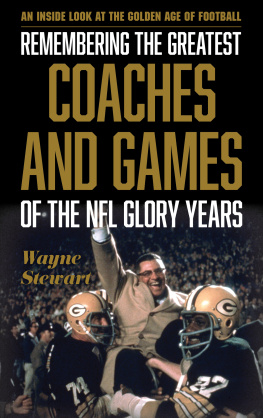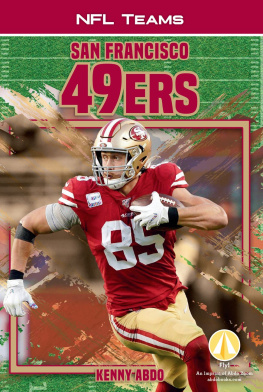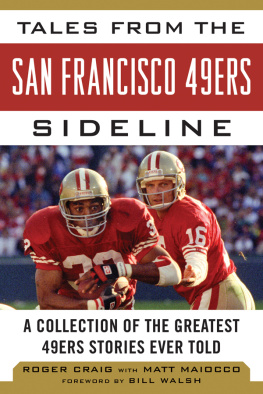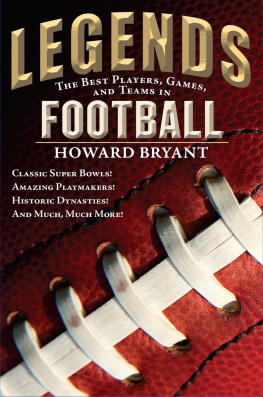SAN FRANCISCO 49ERS
WHERE HAVE
YOU GONE?
SAN FRANCISCO 49ERS
WHERE HAVE
YOU GONE?
JOE MONTANA, Y.A. TITTLE, STEVE YOUNG,
AND OTHER 49ERS GREATS
MATT MAIOCCO
WITH DAVID FUCILLO

Copyright 2005, 2011 by Matt Maiocco
New material copyright 2011 by David Fucillo
All Rights Reserved. No part of this book may be reproduced in any manner without the express written consent of the publisher, except in the case of brief excerpts in critical reviews or articles. All inquiries should be addressed to Sports Publishing, 307 West 36th Street, 11th Floor, New York, NY 10018.
Sports Publishing books may be purchased in bulk at special discounts for sales promotion, corporate gifts, fund-raising, or educational purposes. Special editions can also be created to specifications. For details, contact the Special Sales Department, Sports Publishing, 307 West 36th Street, 11th Floor, New York, NY 10018 or info@skyhorsepublishing.com.
Sports Publishing is a registered trademark of Skyhorse Publishing, Inc., a Delaware corporation.
www.sportspubbooks.com
10 9 8 7 6 5 4 3 2 1
Library of Congress Cataloging-in-Publication Data is available on file.
ISBN: 978-1-61321-045-1
Printed in the United States of America
To Sarah, Jane and Lucy
CONTENTS
PREFACE
Joe Thomas was the 49ers general manager for two seasons in the late 1970s. But in that time he managed to do lasting harm to the organizationfar worse than anything that shows up in the standings.
Thomas wanted to remake the 49ers in his own image. Therefore, he decided to do away with the past. Old photos, programs and memorabilia were tossed into a dumpster behind the team's Redwood City practice facility.
The past was ordered to be forgotten.
While the organization briefly turned its back on all former 49ers, anybody who watched the team during the 1950s, 1960s and 1970s could notand would noterase those memories.
One of those fans of the 49ers during the early years was George Seifert, who as a high-school student served as an usher for games at Kezar Stadium during the 1956 and 1957 seasons.
My job was to point people to their seats, but it was basically just a way to get to watch the 49ers for free, he said.
And when he was not working the games, he found other inventive ways to watch the 49ers. Seifert was on the roof of a classmate's house on Frederick Street, adjacent to Kezar, when R.C. Owens made his first Alley-Oop catch in 1957.
Seifert's first love was the 49ers. He lived and died with the teamand with some of the organization's unpopular decisions. Seifert always had a sense of perspective and appreciation for the past during his eight-year run as head coach of the 49ers from 1989 to 1996.
I remember how frustrated I was as a young man when Red Hickey traded Y.A. Tittle to the New York Giants. How could that idiot coach do something like that? Seifert said. Then I was the idiot coach involved in trading Joe Montana. I thought of all the kids and what they had to be thinking of me.
San Francisco 49ers: Where Have You Gone? is a book intended to catch up with some of the interesting individuals throughout the team's history. After all, the rich tradition of the 49ers goes back much further than 1979, when head coach Bill Walsh took over as the central figure of the organization after owner Eddie DeBartolo fired Thomas.
In the process of writing these profiles, I tried to hit on many of the important games, moments and personalities that reflect the history of the organization. After all, it is a history that should be kept alive, not thrown into a dumpster.
The 49ers underwent an extreme makeover after the club bumbled to a league-worst 2-14 record in 2004. Owner John York hired Mike Nolan to be the 49ers 15th head coach. York said one of the reasons he tabbed Nolan as his coach was because Nolan understands what it means to be head coach of the San Francisco 49ers.
Nolan should know what it means. His father, Dick, was the 49ers sixth head coach. He led the 49ers to the playoffs three times, including back-to-back trips to the NFC Championship Game in 1970 and 1971.
At Nolan's introductory press conference in January 2005 at a posh Nob Hill hotel, some of his father's former players were in attendance. The 49ers had taken another step to reconnect with the past.
Seifert said knowing the history of the 49ers helped him carry out his job, during which time he compiled a remarkable 108-35 record, including two Super Bowl titles.
Even though I was considered a defensive coach, I wanted to make sure we always had an exciting offense, Seifert said. The identity of the franchise from the early years had always been on offense.
Nolan echoed those comments upon accepting the job.
A team needs to not only have its own identity, Nolan said, but the identity of the city and the fans. I believe the winning tradition will carry on.
Seifert, who enjoys the retired life with homes in Bodega Bay and the Tahoe area, is still a fan of the football club he grew up following. And he said he is optimistic for the team's future because Nolan is no outsider.
He has a deep-rooted sense of history about the team, Seifert said. I think that background with the 49ers helps. There's an added juice to it. It helped me, and I'm sure it'll help him, too.
ACKNOWLEDGMENTS
During the course of researching and writing this book, I placed hundreds of phone calls in hopes of tracking down former San Francisco 49ers players from all eras. I was quite pleased with how well this project was received, as only a handful of individuals declined my interview requests.
Fittingly, there are 49 profiles in this book. Some of the players are all-time greats, and some are relatively obscure, but each serves a valuable purpose in the telling of the 49ers history. I am especially appreciative of the individuals who shared their deeply personal stories and answered all my questions: David Kopay, Eason Ramson, Dan Audick, Keith Fahnhorst, Jeff Fuller and Delvin Williams, in particular. Audick also deserves a big assist for volunteering use of all his personal photos from recent 49ers Alumni Days.
I am grateful to my good friend R.C. Owens, who assisted me in getting in contact with many of the interview subjects for this book. Alley-Oop is probably the person most responsible for keeping the history of the 49ers alive through his efforts as the team's alumni coordinator for more than two decades.
Thanks to Keena Turner and Guy McIntyre for their assistance during the 49ers Alumni Weekend in October of 2004. I am also appreciative to 49ers human resource director Annette Snyder and benefits coordinator Sandy Fontana for their help. Bill Walsh was gracious with his time, as I interviewed him about many of the subjects I profiled for this book.
The 49ers public-relations staff was generous in allowing me to rummage through their files. Many thanks to the irreplaceable Kirk Reynolds and his wife, Teri, who set a great example of how to deal with adversity head-on during the tumultuous 2005 offseason. Good luck to them on their future endeavors. The first-rate staff Reynolds assembled was also helpful: Jason Jenkins, Fitz Ollison, Kristina Hartman, Kristin Johnson, Ryan Moore, Matt Kramer and Cindy Krawczyk. I'll miss working with Johnson, Moore and Kramer, who have moved onto other opportunities. Also, thanks to Tom Hastings, the team's manager of internet services.
Next page
